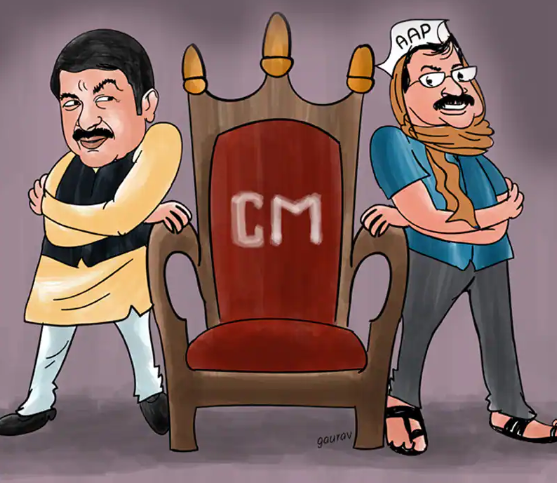History of Delhi
From Ancient Times till 1947
The history of Delhi can be traced to the Harappan Civilization (as found from the recent excavations in the neighbouring region of Haryana). The Mahabharata also has some descriptions of Delhi (Indraprastha), the capital of the Pandavas. Delhi has been a prominent political centre and has even served as the capital of various empires since ancient times. Stronghold of the ruling dynasties throughout history, modern-day Delhi has witnessed numerous invasions. It had a strategic geographical position that was in close proximity to the North-West front of India, the easiest route for maximum attacks as well as the rich, fertile lands of Malwa and Rajputana among others.
The first reference to the place named Delhi seems to have been made in the 1st century BCE when Raja Dhilu built a city near the site of the future Quṭb Mīnār tower (in present-day southwestern Delhi) and named it for himself. Following, all major empires ruling India from the Tomara dynasty (10 CE), the Delhi Sultanate (12 CE – 15 CE) to the Mughal Empire (15 CE – 17 CE) based their capitals in and around Delhi.
Delhi faced raids by the Marathas and Persians before it was brought under British rule in 1803. Delhi was then a part of the province of Punjab, annexed under the Government of India Act, of 1858. The Britishers shifted their capital from Calcutta (Kolkata) to Delhi in 1911. Delhi not only became the capital of India but also was separated from Punjab, and became a Chief Commissioner’s Province. Delhi was chosen as the new capital for several reasons. Suoro D Joardar, professor in the School of Planning and Architecture in New Delhi in his article New Delhi: Imperial Capital to Capital of World’s Largest Democracy (2006) notes that besides the centrality and connectivity of Delhi, it also “carried in the minds of the colonial rulers a symbolic value- as the old saying goes: ‘he who rules Delhi, rules India’- a realisation of the Indian ethos, especially across northern and central India, enhanced during royal contact with the innumerable minor and major princes”. Nonetheless, it was the uproar after the Partition of Bengal that served as the immediate catalyst supporting the decision. New Delhi therefore, emerged as the capital of British India with the complete construction of this new administrative centre in 1931 under the leadership of the key architect Sir Edwin Lutyens.
Post-Independence Administrative History
After much debate, New Delhi was adopted as the capital of Independent India. With the Constitution of India coming into force in 1950, Delhi was designated as a part C state along with other Chief Commissioner’s Provinces. In 1952, the Legislative Assembly of Delhi came into existence before it was abolished in 1956. The State Reorganisation Act of 1956 declared Delhi a Union Territory, eliminating the previous system of Part A, B, C, and D States. Subsequently, the Delhi Municipal Corporation Act, 1957 was enacted which led to the formation of the Municipal Corporation.
In 1966, the Delhi Administration Act replaced the assembly with the Delhi Metropolitan Council with 56 elected and five nominated members with the Lt. Governor of Delhi as its head. The Council however had no legislative powers, only an advisory role in the governance of Delhi. This setup functioned until 1990. With the Constitution 69th Amendment Act, 1991, the recommendations of the Sarkaria Committee (later called the Balakrishnan Committee) were given effect. Articles 239AA and 239AB were inserted in the Constitution: Delhi was given the title of “National Capital Territory of Delhi” and would be administered by a Lieutenant Governor (LG) who was to be appointed by the President. Under the same Act, in 1993, a Legislative Assembly was constituted that could legislate on all matters in the State and Concurrent List except for Public Order, Police, and Land. In addition, a Council of Ministers would be in place to aid and advise the Lt. Governor who was not bound by the former’s advice. In case of a difference of opinion between the Lt. Governor and the Council of Ministers, the matter would be referred to the President.
Before understanding the electoral patterns of Delhi, a look into its administrative composition is essential. Delhi NCT (National Capital Territory of Delhi) is a Union Territory with a Legislative Assembly. It is India’s largest city and has been divided into 11 districts for administrative purposes. New Delhi, one of these 11 districts, is the capital of Delhi NCT as well as the national capital of India. The Central government and the Central government-nominated New Delhi Municipal Corporation jointly administer it. There is also another term that is quite spoken of i.e, Delhi NCR (National Capital Region) – besides Delhi, it includes 24 districts of the neighbouring states of Rajasthan, Haryana, and Uttar Pradesh such as Ghaziabad, Noida, Gurugram, Bharatpur among others.
Delhi NCT (referred to as Delhi hereafter) has grown into a major metropolitan city. Its expansion can be attributed partly to the influx of refugees (particularly Hindus and Sikhs) from Pakistan after the Partition, and partly to the migration from states like Uttar Pradesh, Haryana, and Bihar since the 1950s. The population of Delhi rose rapidly by 1980, leading to the birth of Delhi NCR. In 1985, the Enactment of National Capital Region Planning Board Act was passed to integrate the cities around Delhi to create a single cultural-economic region. Moreover, these cities had been largely influenced by Delhi as the capital city, and their culture and economy got linked to each other which called for synchronised land use and infrastructural development policies. This was made possible through the NCR.
Click Here To Download The Research Paper


📌Analysis of Bills and Acts
📌 Summary of Reports from Government Agencies
📌 Analysis of Election Manifestos

